Greater trochanteric bursitis, also known as hip bursitis or greater trochanteric pain syndrome (GTPS), is inflammation of the bursae near the hip’s greater trochanter, causing pain and discomfort․
Definition and Overview
Greater trochanteric bursitis, now more commonly referred to as greater trochanteric pain syndrome (GTPS), is a condition characterized by inflammation of the bursae near the greater trochanter, a bony prominence on the outer hip․ It often results from repetitive friction, trauma, or underlying conditions like rheumatoid arthritis․ Symptoms include lateral hip pain, tenderness, and discomfort, particularly during activities like walking or lying on the affected side․ While historically attributed to bursitis, GTPS is now understood to involve multiple tissues, including tendons and muscles․ Conservative treatments, such as exercises and physical therapy, are highly effective in managing the condition․
Common Symptoms and Diagnosis
Common symptoms of greater trochanteric bursitis include sharp or dull pain on the outer hip, tenderness to the touch, and discomfort when lying on the affected side or engaging in activities like walking or climbing stairs․ Pain may radiate down the thigh but typically does not pass the knee․ Diagnosis involves a physical examination to identify localized tenderness and swelling near the greater trochanter․ Imaging, such as X-rays or MRIs, may be used to rule out other conditions like fractures or tendon tears․ Early diagnosis is crucial for effective management and recovery․
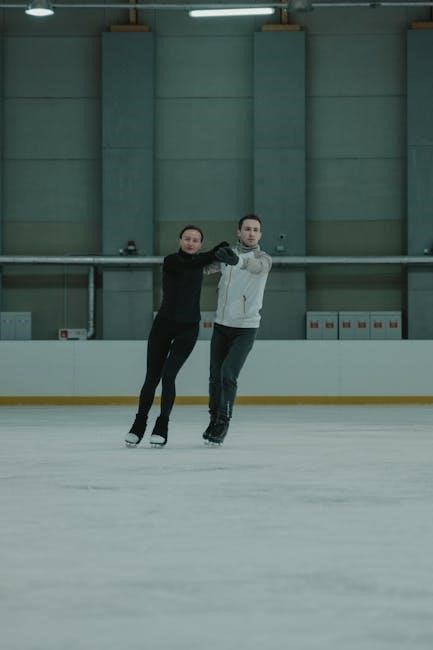
Importance of Exercises in Managing Greater Trochanteric Bursitis
Exercises play a vital role in reducing pain, improving mobility, and strengthening muscles around the hip, aiding in faster recovery and preventing recurrence of bursitis symptoms․
How Exercises Aid in Recovery
Targeted exercises are crucial for reducing inflammation, restoring mobility, and strengthening the muscles around the hip․ They improve joint stability, reduce pain, and prevent recurrence․ By enhancing blood flow and flexibility, exercises promote healing and support the return to normal activities․ Regular physical therapy can also address muscle imbalances, ensuring a more effective and sustainable recovery process․ These non-invasive approaches are often the first line of treatment, offering significant benefits for managing greater trochanteric bursitis effectively․
Benefits of a Structured Exercise Program
A structured exercise program offers numerous benefits, including improved hip strength, enhanced flexibility, and better joint stability․ It helps reduce pain and inflammation, accelerates recovery, and minimizes the risk of recurrence․ Regular exercises promote proper posture and gait, reducing strain on the affected area․ Additionally, a tailored program can address muscle imbalances and improve overall physical function, enabling individuals to resume daily activities and maintain long-term mobility without discomfort․ Consistency in such programs is key to achieving optimal outcomes and preventing future episodes of greater trochanteric bursitis․
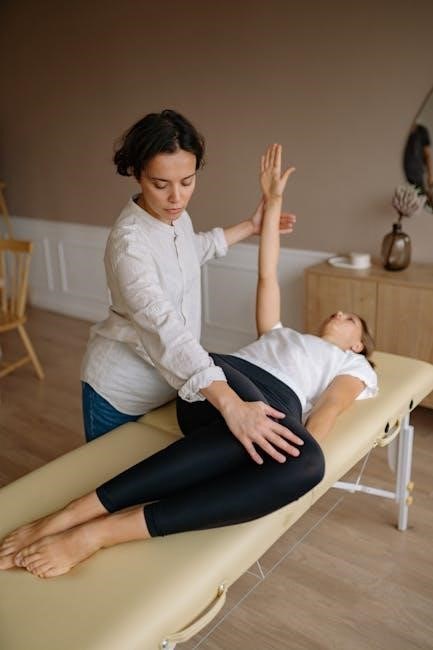
Stretching Exercises for Greater Trochanteric Bursitis
Stretching exercises for greater trochanteric bursitis target the iliotibial band, piriformis, and hip flexors to reduce tightness and improve flexibility, aiding in pain relief and recovery․
Stretching the Iliotibial Band
The iliotibial band runs along the outer thigh, and stretching it helps reduce tightness and alleviate pain associated with greater trochanteric bursitis․ Stand near a wall for support, cross the affected leg behind the unaffected one, and lean toward the unaffected side until a gentle stretch is felt․ Hold for 30 seconds, repeat 2-3 times daily․ This stretch improves flexibility, reduces discomfort, and is an essential part of a recovery program, enhancing overall hip mobility․ Consistency in performing these stretches can lead to better long-term results and prevent recurrence of symptoms․
Piriformis Muscle Stretch
The piriformis muscle, located deep in the buttocks, often contributes to hip pain when tight․ To stretch it, sit on the floor with the affected leg crossed over the unaffected thigh; Place your hand on the knee of the crossed leg and gently pull it toward your opposite shoulder until a stretch is felt․ Hold for 30 seconds, repeat 2-3 times daily․ This exercise helps relieve tension in the piriformis, reducing discomfort and improving hip mobility, which is crucial for managing greater trochanteric bursitis effectively and preventing further inflammation․
Hip Flexor Stretch
Kneel on one knee with the other foot in front, ensuring the back knee is directly under the hips․ Slowly lunge forward, keeping the back leg straight, until a stretch is felt in the front of the hip․ Hold for 30 seconds, then switch sides․ This stretch targets the hip flexors, which, when tight, can exacerbate greater trochanteric bursitis․ Regular stretching improves flexibility and reduces strain on the hip joint, aiding in pain relief and recovery․ Perform 2-3 times daily for optimal results․
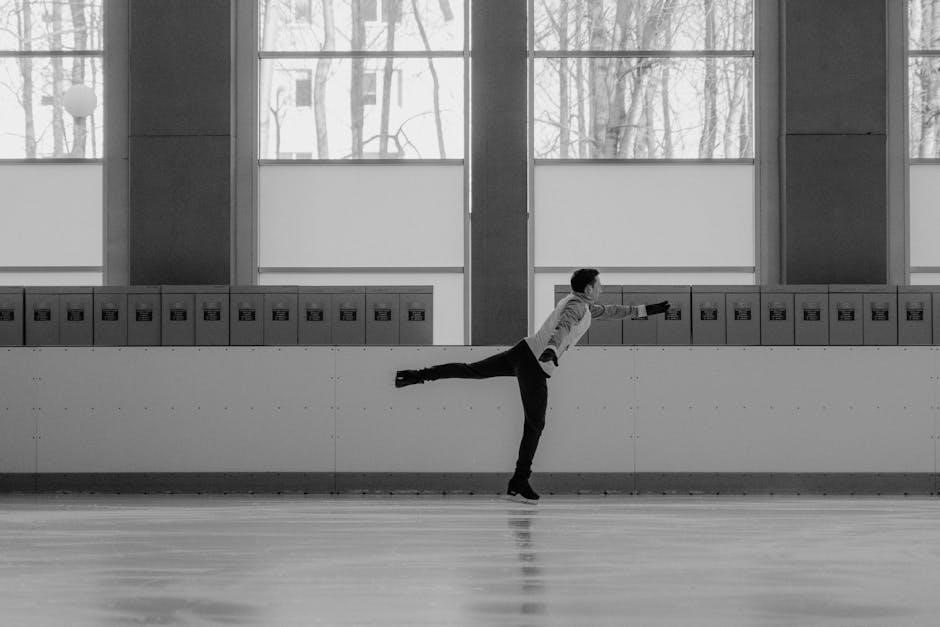
Strengthening Exercises for Greater Trochanteric Bursitis
Strengthening exercises target the hip abductors and glutes, which are essential for stabilizing the hip joint and reducing pain associated with greater trochanteric bursitis․
Clamshell Exercise
The Clamshell exercise strengthens the gluteus medius and minimus muscles, which are crucial for hip stability․ Lie on your side with knees bent and feet touching․ Slowly lift the top knee without moving the feet, holding for 2-3 seconds before lowering․ Start with 2 sets of 10-15 repetitions and gradually increase as strength improves․ This exercise helps reduce hip pain and improves functional mobility in individuals with greater trochanteric bursitis․
Side-Lying Leg Lifts
Side-lying leg lifts target the hip abductor muscles, particularly the gluteus medius and minimus․ Lie on your unaffected side with knees bent at 90 degrees․ Slowly lift the top leg while keeping your feet touching, holding for 2-3 seconds before lowering․ Perform 2 sets of 10-15 repetitions․ This exercise strengthens hip stability, reduces pain, and improves mobility in individuals with greater trochanteric bursitis․ Gradually increase repetitions as strength improves to enhance the effectiveness of the workout․
Bird Dog Exercise
The bird dog exercise strengthens the core and hip stabilizers, improving balance and posture․ Start on hands and knees․ Extend the right arm and left leg simultaneously, holding for 5 seconds․ Alternate sides for 10-12 repetitions․ Engage the glutes to prevent hip sagging․ This exercise enhances hip stability and reduces pain in greater trochanteric bursitis by targeting the gluteus maximus and lower back muscles․ Perform it slowly and maintain a neutral spine to maximize its benefits and avoid strain․ It is an effective addition to a rehabilitation routine․
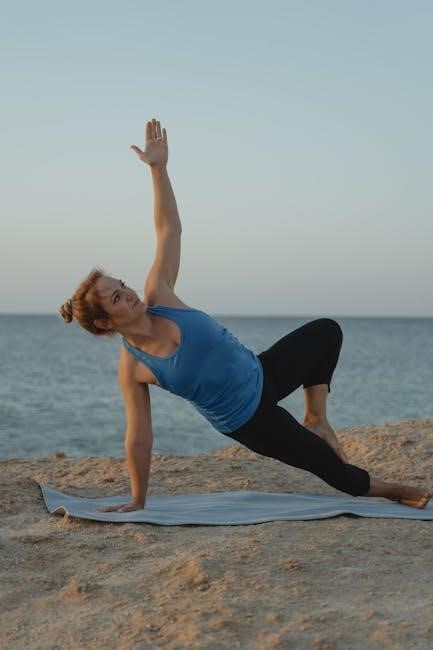
Specific Exercises for Greater Trochanteric Bursitis
Specific exercises target the hip and gluteal muscles to alleviate pain and improve function․ These include isometric abduction, heel slides, quad sets, straight leg raises, and glute bridges․
Isometric Abduction
Isometric abduction strengthens the hip abductors without movement․ Lie on your back with the affected leg near a wall․ Press the foot against the wall, holding for 10 seconds, then relax; Repeat 10-15 times․ This exercise improves hip stability and reduces pain․ Perform it 2-3 times daily for optimal results․ It’s low-impact and ideal for early recovery stages․ Start with shorter holds and gradually increase duration as strength improves․ This exercise is often recommended in physical therapy programs for GTPS management․
Heel Slide Exercise
The heel slide exercise helps improve hip flexor flexibility and reduces tightness․ Lie on your back with knees bent and feet flat․ Slowly slide the affected leg’s heel toward your buttocks, keeping the foot flexed․ Hold for 20-30 seconds, then slowly return to the starting position․ Repeat 2-3 sets․ This gentle stretch targets the hip flexors and can be done daily․ It’s an effective way to enhance mobility and alleviate discomfort associated with greater trochanteric bursitis․ Start with shorter holds and gradually increase as comfort allows․
Quad Sets
Quad sets are isometric exercises targeting the quadriceps muscles to improve strength and stability․ Lie on your back with legs straight, squeeze the quadriceps to press the back of your knees into the floor․ Hold for 5-10 seconds, then release․ Perform 10-15 repetitions․ This exercise strengthens the muscles around the hip and knee, improving joint stability and reducing discomfort․ It’s a low-impact, gentle exercise suitable for early stages of recovery from greater trochanteric bursitis․ Progress by increasing hold time or adding resistance as strength improves․
Straight Leg Raise
The straight leg raise is an isometric exercise that strengthens the hip flexors and quadriceps without stressing the joint․ Lie on your back with the affected leg straight and the other knee bent․ Tighten the quadriceps of the straight leg, then lift it 8-10 inches, keeping the knee straight․ Hold for 5-10 seconds, then lower slowly․ Perform 10-15 repetitions․ This exercise improves hip mobility and strengthens surrounding muscles, aiding in recovery from greater trochanteric bursitis․ It’s a gentle, low-impact option for early stages of rehabilitation․
Glute Bridges
Glute bridges are an effective strengthening exercise for the gluteal muscles, which play a crucial role in hip stability and movement․ Lie on your back with knees bent and feet flat on the floor․ Slowly lift your hips toward the ceiling, squeezing your glutes at the top, then lower back down․ This exercise strengthens the glutes, improves hip mobility, and reduces strain on the trochanteric bursae․ Regular glute bridges can help alleviate pain and improve functional movement in individuals with greater trochanteric bursitis․ Perform 2-3 sets of 10-15 repetitions daily for optimal results․
Step-Ups
Step-Ups are a functional exercise targeting the gluteal muscles and improving hip strength․ Stand in front of a sturdy step or platform․ Step up with one leg, bringing the other to meet it, then step down carefully․ This exercise enhances hip stability, strength, and mobility․ It is particularly beneficial for reducing pain and improving function in individuals with greater trochanteric bursitis․ Perform 2-3 sets of 10-12 repetitions on each leg, ensuring proper form to avoid exacerbating symptoms․ Gradually increase step height as strength improves․
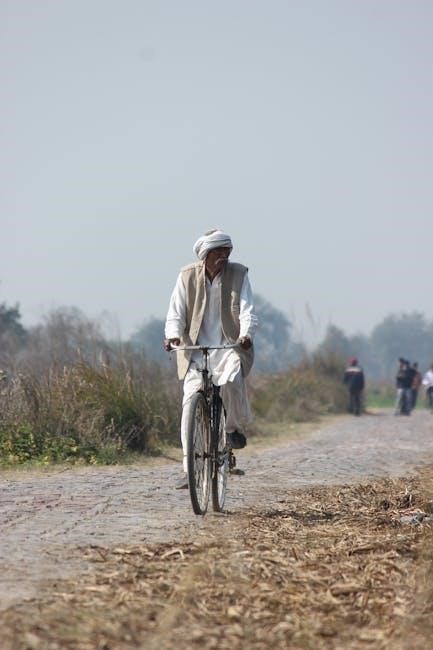
When to Avoid Certain Exercises
Certain exercises should be avoided during acute inflammation or severe pain, such as heavy weight-bearing activities or high-impact movements, which may worsen symptoms and delay recovery․
Exercises That May Worsen Symptoms
Certain exercises can exacerbate greater trochanteric bursitis symptoms, particularly those involving repetitive hip movements or heavy weight-bearing․ Activities like deep squats, lunges, or high-impact aerobics can increase inflammation and pain․ Additionally, exercises that involve direct pressure on the hip, such as prolonged sitting or lying on the affected side, may worsen discomfort․ It is crucial to avoid movements that cause sharp pain or discomfort, as this can delay recovery․ Instead, focus on low-impact activities and gentle stretches to promote healing without aggravating the condition․
Activities to Avoid During Recovery
During recovery from greater trochanteric bursitis, it is essential to avoid activities that may exacerbate symptoms․ Prolonged sitting, heavy lifting, or repetitive hip movements can worsen inflammation․ High-impact sports, such as running or jumping, should be avoided to prevent further irritation․ Activities that involve direct pressure on the hip, like lying on the affected side, can also increase discomfort․ Avoiding these movements helps reduce strain on the hip joint and promotes a faster, more effective recovery․ Instead, focus on low-impact exercises like swimming or cycling to maintain mobility without aggravating the condition․
Home Remedies and Conservative Treatment
Home remedies for greater trochanteric bursitis include rest, ice therapy, and compression to reduce inflammation․ Elevation of the affected leg can also alleviate discomfort and promote healing․
Rest and Ice Therapy
Rest and ice therapy are essential for managing greater trochanteric bursitis․ Applying ice packs to the affected area for 15-20 minutes, several times a day, helps reduce inflammation and pain․ Resting the hip by avoiding activities that aggravate the condition, such as prolonged sitting or heavy lifting, allows the bursae to heal․ Combining these methods with structured exercises can accelerate recovery and prevent further complications․ This conservative approach is often recommended before considering more invasive treatments․
Use of Compression and Elevation
Compression and elevation are effective in reducing swelling and pain associated with greater trochanteric bursitis․ Using a compression bandage or wrap around the hip area helps minimize inflammation․ Elevation involves lifting the affected leg above heart level to reduce fluid retention and promote blood flow․ These methods, combined with rest and ice therapy, create a comprehensive approach to alleviate symptoms and support the healing process․ Regularly applying these techniques can significantly improve comfort and accelerate recovery․
Daily Routine and Exercise Plan
A daily routine incorporating conservative treatments like rest, ice, and structured exercises can effectively manage symptoms and support recovery, while avoiding activities that worsen pain․
Sample Exercise Routine for Recovery
A typical exercise routine for recovery includes gentle stretches and strengthening exercises․ Start with straight leg raises, heel slides, and quad sets to improve flexibility and strength․ Gradually incorporate isometric abduction and glute bridges to target the hip muscles․ Perform each exercise 2-3 times daily, holding stretches for 20-30 seconds and repeating 3-5 times․ Avoid movements that cause pain․ Progress exercises as tolerance allows, focusing on controlled movements to prevent irritation of the bursae․
Progression of Exercises Over Time
Exercise progression for greater trochanteric bursitis begins with gentle stretches and isometric exercises to reduce inflammation․ As pain subsides, introduce strengthening exercises like clamshell and side-lying leg lifts․ Gradually incorporate dynamic movements, such as bird dog and step-ups, to improve hip stability․ Resistance bands or light weights can be added for increased intensity․ Balance exercises and functional activities are introduced in later stages to restore normal mobility․ Progression should be slow and tailored to individual tolerance, avoiding any movements that exacerbate symptoms․
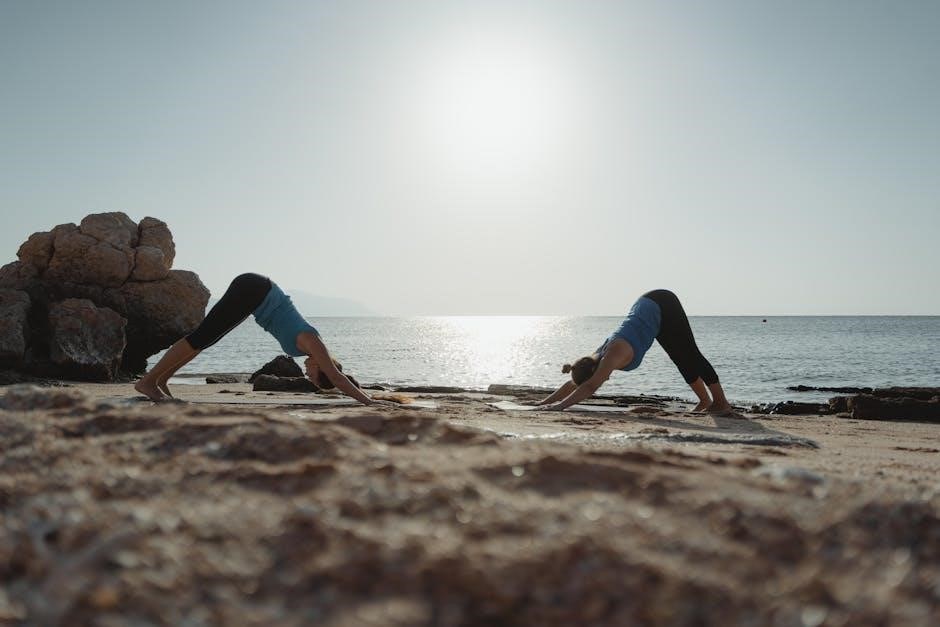
Rehabilitation and Recovery Timelines
Recovery from greater trochanteric bursitis typically ranges from 6 to 12 weeks with consistent exercise and therapy․ Early stages focus on reducing inflammation, while later phases emphasize strength and mobility․
Expected Duration of Recovery
The recovery duration for greater trochanteric bursitis typically ranges from 6 to 12 weeks with proper treatment․ The acute phase lasts 2-4 weeks, focusing on pain reduction and inflammation control․ Gentle exercises like isometric abductions and straight leg raises are introduced early to maintain strength without aggravating the condition․
The subacute phase (4-8 weeks) involves progressive strengthening and mobility exercises, such as clamshell exercises and hip flexor stretches․ Full recovery is achieved when pain subsides and normal hip function resumes․ Adherence to a structured exercise program accelerates healing and prevents recurrence․
Factors Influencing Recovery Time
The duration of recovery from greater trochanteric bursitis varies based on several factors, including the severity of inflammation, adherence to treatment plans, and individual health conditions․ Patients who consistently perform prescribed exercises, such as isometric abductions and hip flexor stretches, often experience faster recovery․ Underlying conditions like rheumatoid arthritis or obesity may prolong healing․ Additionally, the effectiveness of the exercise program and the presence of any complications, such as infections, play a significant role․ A structured approach and medical guidance are essential for optimal recovery․

Role of Physical Therapy
Physical therapy plays a crucial role in managing greater trochanteric bursitis by designing personalized exercise programs and incorporating manual therapy to enhance mobility, strength, and reduce pain, promoting recovery․
How Physical Therapists Can Assist
Physical therapists play a vital role in managing greater trochanteric bursitis by designing personalized exercise programs tailored to the patient’s needs․ They utilize manual therapy techniques, such as soft tissue mobilization and joint mobilization, to reduce pain and improve hip mobility․ Additionally, therapists educate patients on proper posture, gait mechanics, and activity modification to prevent further irritation․ They also monitor progress, adjusting treatment plans as necessary to ensure optimal recovery and functional restoration, helping patients return to their daily activities pain-free․
Manual Therapy Techniques
Physical therapists employ manual therapy techniques to address greater trochanteric bursitis, focusing on reducing pain and restoring hip function․ Soft tissue mobilization targets tight or inflamed tissues around the greater trochanter, while joint mobilization improves hip joint mobility․ Trigger point therapy alleviates tension in the gluteal and piriformis muscles, which often contribute to bursitis symptoms․ These hands-on methods enhance the effectiveness of exercises, promoting healing and reducing inflammation․ Regular manual therapy sessions can significantly accelerate recovery and improve overall hip mechanics․

Prevention of Recurrence
Preventing greater trochanteric bursitis recurrence involves maintaining hip strength, proper posture, and avoiding repetitive strain․ Regular exercise and activity modification can significantly reduce the risk of relapse․
Lifestyle Modifications
Lifestyle changes play a crucial role in preventing greater trochanteric bursitis recurrence․ Maintaining a healthy weight reduces hip strain, while avoiding prolonged sitting or standing decreases inflammation․ Incorporating low-impact activities like swimming or cycling can improve hip mobility without overloading the joint․ Proper footwear and ergonomic adjustments at work or home also minimize repetitive stress․ Additionally, smoking cessation and managing chronic conditions like arthritis can further reduce the risk of flare-ups, promoting long-term joint health and stability․
Long-Term Exercise Strategies
For sustained recovery, long-term exercise strategies focus on maintaining hip strength and flexibility․ Incorporating activities like yoga or Pilates can enhance core stability and balance, reducing the risk of re-injury․ Gradually increasing the intensity of low-impact exercises, such as cycling or swimming, helps maintain joint mobility without causing stress․ Consistency in a structured exercise routine, tailored to individual needs, is key to preventing future episodes of greater trochanteric bursitis and promoting overall hip health․
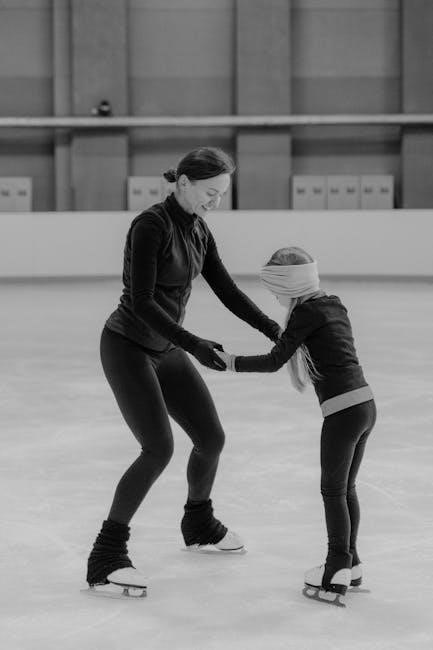
References and Further Reading
Key references include the American Association of Hip and Knee Surgeons (AAHKS) guidelines, studies from Mayo Clinic Proceedings, and systematic reviews in Clinical Journal of Sport Medicine․
These sources provide evidence-based exercises and treatment strategies for greater trochanteric bursitis․
Additional resources are available through orthopedic associations and physical therapy journals․
Recommended Resources and Studies
For further reading, consult the American Association of Hip and Knee Surgeons (AAHKS) guidelines and studies published in Mayo Clinic Proceedings and Clinical Journal of Sport Medicine․
Shbeeb and Matteson’s 1996 study in Mayo Clinic Proceedings provides detailed insights into trochanteric bursitis․
The systematic review in Clinical Journal of Sport Medicine (2011) offers evidence-based exercise strategies․
Additional resources include orthopedic association websites and physical therapy journals․
PDF guides from reputable organizations are also available online for comprehensive exercise plans․
Greater trochanteric bursitis, or GTPS, is a treatable condition with a focus on exercises and conservative care․ Properly designed exercise programs, including stretching and strengthening, can significantly improve symptoms and function; Early intervention, patient education, and adherence to treatment plans are crucial for optimal recovery․ Consulting healthcare professionals ensures personalized care and prevents recurrence․ With consistent effort and the right approach, individuals can effectively manage GTPS and return to normal activities․ For further guidance, refer to recommended resources and studies on exercise strategies and rehabilitation․

